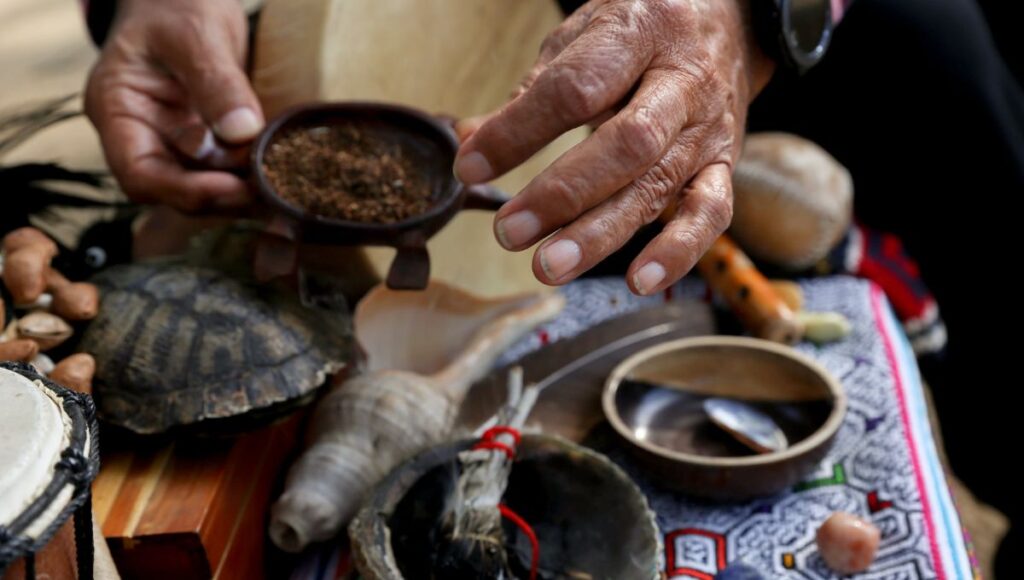
Sage For Cleansing: How To Burn Sage, Benefits, Rituals & Indigenous Roots
Sage burning, also known as smudging, is an ancient and sacred ritual that has traversed cultures and generations, originating from indigenous traditions.
This practice involves burning sage leaves to cleanse spaces, banish negative energies, and invite positivity and clarity into one’s life. As we delve into the intricacies of this ritual and how to burn sage , it’s essential to understand its roots, benefits, and the respect it deserves.
We’ll look into:
- Exploring the Sacred Origins of Sage Burning
- How To Burn Sage: Respect and Reverence for the Practice
- The Benefits of Burning Sage
Exploring the Sacred Origins of Sage Burning
Indigenous Origins Across Continents
Sage burning is an ancient practice woven intricately into the cultural tapestry of diverse indigenous communities worldwide.
Its roots trace back to the practices of Native American tribes, Indigenous Australians, and various Central and South American cultures.

Despite geographical differences, these cultures share a common reverence for sage as a sacred herb, using it for purification, healing ceremonies, and spiritual rituals.
Native American Traditions:
Among Native American cultures, sage, particularly white sage (Salvia apiana), holds immense significance. It’s regarded as a purifying herb used in ceremonies to cleanse spaces, individuals, and ceremonial tools. Burning sage in a ritualistic manner is an essential part of various ceremonies, including sweat lodges, vision quests, and smudging rituals.
Indigenous Australian Practices:
In Indigenous Australian cultures, the burning of native plants like various types of eucalyptus leaves or acacia branches, similar to sage burning, is a customary practice. These ceremonies, known as “smoking ceremonies,” are performed to cleanse and protect individuals, spaces, and important items.
Central and South American Traditions:
Across Central and South America, indigenous cultures have their variations of sage-like herbs used for spiritual cleansing. For instance, copal resin or Palo Santo is burned ceremonially in shamanic practices to clear negative energies and invite positive influences.
Sage as a Symbol of Wisdom and Protection
Sage holds symbolic significance, representing wisdom, purity, and protection within these indigenous cultures. It represents the connection between the physical and spiritual realms, serving as a conduit for communication with the spiritual world.
Its aroma is believed to clear the mind, allowing for deeper spiritual insights and connection to higher energies.
Sage is revered for its ability to impart wisdom and spiritual clarity. Burning sage is believed to enhance intuition, promote mental acuity, and facilitate deeper meditation or prayer.
As a purifying agent, sage smoke is thought to clear negative energies, emotional imbalances, and even stagnant air, creating a clean and energetically balanced environment.
Sage is also seen as a protective herb, shielding against malevolent influences and promoting physical, emotional, and spiritual healing.
Central to the indigenous practice of sage burning is a deep reverence for nature and a harmonious relationship with the environment.

These cultures view plants and herbs as allies, recognizing their healing properties and their ability to connect individuals with the natural world.
Sage burning isn’t merely a ritual; it’s a way of honoring ancestral traditions and preserving cultural heritage. Indigenous communities hold deep respect for the sacredness of sage and its ritualistic use, passing down this wisdom through generations.
How To Burn Sage: Respect and Reverence for the Practice
Approaching the practice of burning sage with reverence and respect is essential to uphold its cultural sanctity and honor the traditions from which it emanates.
Honoring Ancestral Wisdom:
Sage burning isn’t just a ritual; it embodies centuries of wisdom passed down through generations within indigenous communities. Acknowledging its origins and the deep spiritual insights associated with this practice is vital to respect its heritage.
Cultural Reverence:
Indigenous cultures consider sage a sacred herb, revered for its spiritual properties. It’s crucial to approach its burning with the same reverence as one would approach a sacred ceremony or ritual.
Intent and Mindfulness:
Before igniting the sage, set clear intentions and approach the ritual mindfully. Express gratitude and acknowledge the sacredness of the act, understanding that it’s more than a simple cleansing—it’s a spiritual endeavor.
Authenticity and Authentic Sourcing:
When procuring sage bundles or related materials, consider sourcing them authentically from indigenous suppliers or reputable sources that honor the cultural significance of these herbs.
Supporting indigenous communities or ethical sources ensures respect for their cultural practices.

Conscious Use:
Be mindful during the burning process, allowing the sage to smolder and produce cleansing smoke. Move gently through spaces, ensuring the smoke reaches corners and crevices while maintaining a respectful demeanor.
Gratitude and Closure:
Once the smudging is complete, extinguish the sage bundle in a fireproof container. Offer gratitude for the cleansing and protection provided by the ritual. Express respect for the space and its renewed positive energy.
Cultural Education: Develop a deeper understanding of the traditions, customs, and significance associated with sage burning. Engage in cultural education and awareness to honor and preserve the authenticity of indigenous practices.
Respectful Sharing: If sharing the practice with others, do so with care and respect, ensuring that the cultural significance and reverence for sage burning are conveyed appropriately.
How To Burn Sage: Performing a Sage Burning Ritual
Materials Required:
- Sage bundle (commonly white sage or other variations like desert sage or blue sage)
- Fireproof container (such as an abalone shell or ceramic dish)
- Matches or a lighter

Steps to Perform Sage Burning:
- Prepare the Space: Ensure windows are open to allow negative energies to exit. Light the sage bundle until it smolders, then gently blow out the flame, allowing the smoke to billow.
- Set Intentions: Before starting, set clear intentions for the cleansing. Focus on positive energy, peace, and purification.
- Cleansing Ritual: Holding the sage bundle, move clockwise around the space, allowing the smoke to reach corners, doorways, and windows. Use a feather or your hand to fan the smoke gently.
- Closing the Ritual: Once finished, extinguish the sage bundle in the fireproof container. Express gratitude for the cleansing and protection it provides.
How To Burn Sage: Where and When
Optimal Spaces for Sage Burning
Homes and Living Spaces:
Sage burning is ideal for homes, particularly in areas where negative energy tends to linger. Consider smudging rooms that have witnessed arguments, stress, or emotional tension. It’s beneficial after significant life changes, such as moving into a new home, to cleanse residual energies from previous occupants.
Work Environments:
Offices and workplaces often accumulate stress and tension. Burning sage in these spaces can help clear the air after challenging meetings, office conflicts, or periods of high workload. It creates a more harmonious and conducive environment for productivity.
Healing Spaces:
Places dedicated to healing or therapy, such as yoga studios, massage parlors, or counseling offices, greatly benefit from sage burning. It assists in clearing residual energies from client sessions, maintaining a fresh and balanced atmosphere.

Areas with Emotional Intensity:
Spaces where heightened emotions are experienced, such as meditation rooms, bedrooms, or areas designated for self-reflection, can benefit from sage burning. It supports emotional release and provides a tranquil environment for introspection.
Times and Occasions for Sage Burning
After Significant Life Events:
Following major life changes like moving houses, ending relationships, or experiencing loss, burning sage can aid in clearing old energies and initiating a fresh start. It symbolizes closure and the beginning of a new chapter.
Post-Illness or Stressful Situations:
After periods of illness or times of prolonged stress, sage burning can help restore balance and vitality. It assists in releasing residual tension, promoting recovery, and rejuvenation.
During Meditation or Spiritual Practices:
Before or after meditation, yoga, prayer, or any spiritual practice, burning sage can help create a sacred space. It supports focus, clarity, and enhances the spiritual connection, elevating the overall experience.
When Feeling Emotionally Overwhelmed:
During moments of emotional overwhelm or anxiety, sage burning offers a tangible way to release negative energies and create a more serene environment.
Seasonal Cleansing:
Performing sage burning rituals during seasonal changes, such as the start of a new year, solstices, or equinoxes, can signify renewal and cleansing for a fresh beginning.
Before Social Gatherings:
Before hosting events or gatherings, burning sage can clear any residual energies and create a welcoming atmosphere for guests.
Before Sleep or Rest:
Smudging before bedtime can help clear the mind, release daily stress, and promote a restful and rejuvenating sleep.
After Negative News or Media Exposure:
Following exposure to distressing news or negative media, sage burning can aid in releasing the accumulated negativity and restore emotional equilibrium.

The Benefits of Burning Sage
1. Purification and Cleansing
Clearing Negative Energies: Sage burning is renowned for its ability to dispel negative energies. The smoke from burning sage is believed to neutralize and cleanse the air, removing stagnant or negative energies that may linger in spaces, objects, or individuals.
Energetic Renewal: By smudging with sage, one can invite a sense of renewal, purifying not only the environment but also the mind and spirit. This cleansing ritual helps reset the energy, fostering a fresh start and a more positive atmosphere.
2. Emotional and Mental Well-being
Stress Reduction: The aromatic properties of sage smoke can promote relaxation and alleviate stress. The ritualistic act of burning sage encourages a calm atmosphere, facilitating emotional balance and reducing anxiety.
Clarity and Mental Focus: Smudging with sage is associated with heightened mental clarity and improved focus. The practice can help clear mental clutter, allowing for enhanced concentration and a more tranquil state of mind.
3. Spiritual Connection and Harmony
Spiritual Alignment: Sage burning aids in creating a sacred space conducive to meditation, prayer, or spiritual practices. It develops a deeper connection to one’s inner self and the spiritual realm, facilitating introspection and a sense of inner harmony.
Enhanced Intuition: Sage is believed to heighten intuition and increase spiritual awareness. The practice of burning sage can create an environment that encourages intuitive insights and a greater connection to one’s inner wisdom.
4. Physical Environment and Wellness
Air Purification: Beyond spiritual benefits, sage smoke possesses antimicrobial properties, contributing to air purification by reducing airborne bacteria. This aspect can potentially support physical health by creating a cleaner environment.
Promoting Restful Sleep: Smudging before bedtime can promote relaxation and aid in achieving a more restful sleep by creating a serene environment free from negative energies.
Conclusion
Sage burning, an ancient indigenous practice, offers a powerful tool for cleansing, purification, and spiritual connection.
As we engage in this ritual, it’s crucial to honor its roots, respect its cultural significance, and perform it with mindfulness and intentionality.


